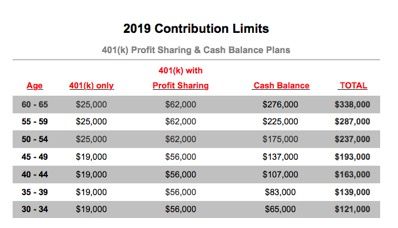The Underused Retirement Planning Strategy That Can Turbo-charge Your 401(k) Plans
Student loans and extra taxes are unique challenges to your retirement and financial planning, but there is one strategy that might be able to help with both of those challenges. A Cash Balance Plan.

As a Dentist, you are in a unique position to experience certain challenges when saving for retirement, but you're also in a unique position to save better than most.
Dentists can experience unique challenges when it comes to retirement and financial planning for two main reasons:
- The tax burden associated with high incomes and a successful practice
- Many medical professionals may have spent a decade or more paying down student loans and building their practices, so they may have fallen behind on retirement savings.
However, a little-known retirement plan called a Cash Balance plan is an innovative way to help dentists save as much as $2.9 million tax-deferred for retirement, reducing the annual tax bite and accelerating the savings rate dramatically. Annual contribution limits for a Cash Balance plan are age-weighted, allowing older owners to double or triple their pre-tax contributions.
What is a Cash Balance Plan?
Cash Balance plans have been around for more than three decades, but due to their perceived complexity, few understand their benefits. The first ever IRS-approved Cash Balance plan was implemented by Bank of America in 1985, but they didn’t gain broader awareness until 2006 when the Pension Protection Act (PPA) clarified certain legal issues and made the plans easier to implement. Since then, the number of new plans added has been increasing at an average rate of 20% per year — the more people know about them, the more popular they become.
A Cash Balance plan is a type of IRS-qualified retirement plan also known as a “hybrid” since it has features of both defined benefit and defined contribution plans. Cash Balance plans combine the high contribution limits of a defined benefit plan with the flexibility and portability of a 401(k) plan.
The Difference between a Cash Balance Plan and a 401(k) Plan
The most significant difference between a Cash Balance plan and a 401(k) plan lies in the enhanced contribution amounts allowed through a Cash Balance plan, and the tax relief that can be realized for business owners.
For example, a Cash Balance plan is not restricted by the annual contribution limits of a 401(k) plan ($19,000 in 2019) or a Profit Sharing plan ($56,000). For this reason alone, this plan type is attractive to high-income earners.
“Many physician groups who have reached out to us for help have the same common concerns about partners being unprepared for retirement,” said Dan Kravitz, whose firm specializes in designing and implementing Cash Balance plans. “Many doctors enter their 50s or 60s and are a decade or more behind in their savings. A Cash Balance plan can help them squeeze 20 years of retirement savings in to 10.”
Who Is a Good Fit for A Cash Balance Plan?
Cash Balance plans are a good fit for the following business owners, entrepreneurs, or professionals:
- Business owners or partners in firms with consistent profitability and discretionary income who want to take advantage of higher contribution limits.
- Owners who want to make additional pre-tax contributions to reduce taxes. (For this reason, 48% of Cash Balance plans are in place at medical/dental groups and law firms.* Dentists are fortunate to have a significant amount of discretionary income and are often good candidates).
- Owners who want to accelerate their retirement plan savings.
*2018 National Cash Balance Research Report (Kravitz)
Simply put, Cash Balance plans allow high-income earners to maintain their current lifestyle without being hindered by high taxes. If the money isn’t needed today, why not defer paying income taxes on those dollars to a future day when it will be taxed at a lower rate?
Retirement Savings and Tax Relief by the Numbers
Depending on your age, contribution amounts are bolstered in addition to your 401(k) and Profit Sharing contributions. Essentially, a 60-year-old could defer taxes on $338,000 of income in 2019. That’s a meaningful tax deduction for anyone, but especially for those in their peak earning years with little debt. During these years, expenses are down and your income is at its highest level. If you take the tax deduction today and defer your tax bill to a future date, when your withdrawals and taxable income reflect only what you need, you pay significantly less in taxes over time.
The table below shows the contribution limits for this year, along with the possible total amount you could save.

(Source:Kravitz, Inc. Used with permission)
Cash Balance Plans: A Deeper Dive
Because a Cash Balance plan is a hybrid of both a defined benefit and defined contribution plan, you can amass a lump sum of up to $2.9 million while employed. Unlike a defined benefit plan, the account balance does not need to be taken as a monthly payment or annuity. You can choose to have the lump sum rolled over to an IRA when you terminate employment or reach the retirement age designated by the plan document, typically 62. You then may withdraw funds over time, much like distributions from a 401(k) or Profit Sharing plan.
An employer-funded Cash Balance plan grows in two ways:
- Through annual contributions—which may be based on a percentage of pay or a flat dollar amount.
- Through an Interest Crediting Rate (ICR), which may be based on a flat rate, an index such as U.S. Treasury or corporate bond yields, or the “actual rate of return” on plan investments.
Annual contribution amounts are not discretionary as they are in a 401(k) plan, they are written into the plan document as a flat amount or a percentage of pay. The amount may be amended periodically, and the plan can be frozen or terminated for business necessity, but in general, participants need to be comfortable with the committed contribution amounts. The plan does not technically have a defined monthly benefit that pays out every month at a certain age, but it does have a theoretical defined benefit payout based on the $2,900,000 maximum account balance paid out over 10 years (e.g., $290,000 per year).
Cash Balance plans are not a fit for everyone, but dentists are among those most poised to benefit from them.
For more of the best personal finance tips and guides, read on here!
Matthew White is a Partner at White and McGowan Financial in Little Rock, AR.